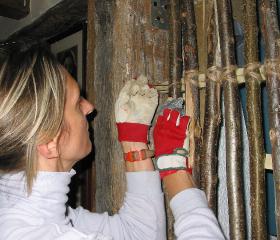
Image Credit: Paula Sunshine
After their first couple of decades, many conventionally constructed houses may start to seem “old” to their occupants. Tile grout goes missing, fixtures fail, the exterior needs repair, and the roof needs to be replaced. The maintenance list expands well beyond the usual, annual priorities.
But old by those standards is nothing compared to old by the standards of the oak-frame home occupied by Paula Sunshine, who lives in Suffolk County, England, and has taught herself and others a lot about the construction techniques used to build the home, which dates back to the 16th century.
Sunshine has studied under the Prince of Wales’s Craft Scholarship Scheme, a program designed to train people in the building trades to properly handle repairs and remodels of Britain’s fairly large stock of ancient buildings. On her Web site, she notes that she has written two books on the subject and offers training to homeowners and contractors who want to learn about timber-frame construction and materials.
Most typically, the walls in these buildings were framed with green timber. Hazel sticks (known as wattle) would be tied to the frame and serve as a lath panel on which a mixture of clay and straw would be applied with a trowel. Oak strips fastened to the exterior serve as the foundation for a layer of rendered daub and, on top of that, a mixture of lime and hair (usually human hair).
The daub is hard when it dries, but also surprisingly flexible and thermally resistant. Sunshine points out that a timber-frame home built with wattle-and-daub construction is in many ways a green home, particularly because it requires only locally produced materials (except for the lime). The primary drawback to this type of construction, Sunshine says, is that it is extremely labor intensive.
Click here to view a recent BBC interview with Sunshine that includes demonstrations of some of the techniques she uses for timber-frame wall repair.
Weekly Newsletter
Get building science and energy efficiency advice, plus special offers, in your inbox.














0 Comments
Log in or create an account to post a comment.
Sign up Log in